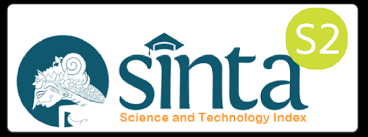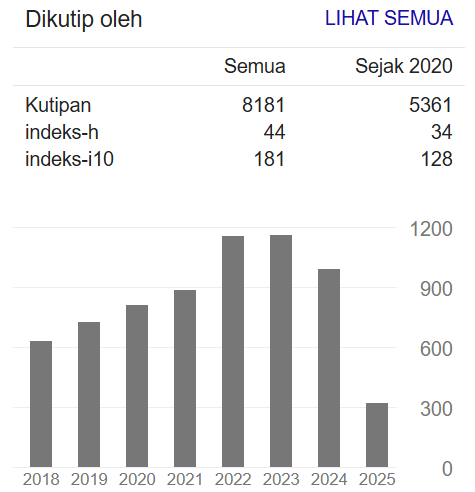PERCEIVED INSUFFICIENT MILK SUPPLY AND EXCLUSIVE BREASTFEEDING: A SYSTEMATIC REVIEW OF CONTRIBUTING FACTORS
DOI:
https://doi.org/10.34011/jmp2k.v35i4.3305Keywords:
ASI eksklusif, faktor yang berkontribusi, ibu menyusui, ketidakcukupan produksi ASIAbstract
Persepsi ketidakcukupan air susu ibu (perceived insufficient milk supply/PIMS) merupakan hambatan utama dalam pemberian ASI eksklusif (ASI-E) dan berkontribusi pada penghentian dini meskipun manfaat ASI sudah terbukti secara luas. Kajian sistematis ini bertujuan mensintesis bukti terbaru mengenai faktor-faktor penentu PIMS untuk memperkuat intervensi yang lebih terarah. Pencarian literatur dilakukan melalui PubMed, ScienceDirect, SpringerLink, SagePub, dan Google Scholar untuk artikel yang diterbitkan antara Januari 2020 hingga Mei 2025. Artikel yang memenuhi syarat adalah publikasi terindeks, berbahasa Inggris, dengan desain penelitian kuantitatif atau kualitatif yang membahas faktor biologis, psikologis, sosial, pekerjaan, atau pendidikan terkait PIMS. Kriteria eksklusi mencakup studi yang tidak secara eksplisit menilai persepsi ibu atau yang terbatas pada determinan umum menyusui. Dari 1.280 artikel yang disaring, sepuluh memenuhi kriteria: delapan studi potong lintang, satu uji klinis teracak, dan satu meta-analisis. Penilaian risiko bias dilakukan sesuai desain, menggunakan Newcastle–Ottawa Scale untuk studi potong lintang, Cochrane RoB 2.0 untuk uji klinis, dan AMSTAR-2 untuk meta-analisis. Hasil telaah konsisten menunjukkan bahwa stres ibu, depresi pascapersalinan, pendidikan rendah, minimnya dukungan pasangan, kondisi kerja yang kaku, serta kemiskinan merupakan prediktor utama PIMS. Kajian ini menegaskan bahwa struktur kerja dan kesehatan mental ibu secara bersama-sama membentuk PIMS, sehingga diperlukan reformasi kebijakan ketenagakerjaan serta intervensi kesehatan mental untuk mendukung keberlanjutan ASI eksklusif.
References
World Health Organization, “Exclusive breastfeeding for six months best for babies everywhere.” [Online]. Available: https://www.who.int/news/item/15-01-2011-exclusive-breastfeeding-for-six-months-best-for-babies-everywhere
C. G. Victora, R. Bahl, A. J. D. Barros, G. V. Franca, S. Horton, and J. Krasevec, “Breastfeeding in the 21st century: Epidemiology, mechanisms, and lifelong effect’,” The Lancet, vol. 387, no. 10017, pp. 475–490, 2016.
Brown, S., “Perceived insufficient milk supply: A common barrier to breastfeeding Journal of Human Lactation,” Journal of Human Lactation, vol. 34, no. 4, pp. 645–656, 2018, doi: https://doi.org/10.1177/0890334418769619.
Odom, S. L., et al., A. Surie, and G. Bhan, “Reasons for earlier than desired cessation of breastfeeding Pediatrics,” American Academy of Pediatrics, vol. 131, no. 3, pp. e726–e732, 2013, doi: https://doi.org/10.1542/peds.2012-1295.
R. Vila-Candel, F. J. Soriano-Vidal, C. Franco-Antonio, O. Garcia-Algar, V. Andreu-Fernandez, and D. Mena-Tudela, “Factors Influencing Duration of Breastfeeding: Insights from a Prospective Study of Maternal Health Literacy and Obstetric Practices,” Nutrients, vol. 16, no. 5, p. 690, Feb. 2024, doi: 10.3390/nu16050690.
N. Sriraman K and A. Kellams, “Breastfeeding: What are the Barriers? Why Women Struggle to Achieve Their Goals,” Journal of Women’s Health, vol. 25, no. 7, pp. 714–722, Jul. 2016, doi: https://doi.org/10.1089/jwh.2014.5059.
B. M. Gee, N. L. Aubuchon-Endsley, and A. Prow, “Perinatal Maternal Mental Health and Breastfeeding Are Associated with Infant and Toddler Sensory Profiles,” Children, vol. 8, no. 9, p. 766, Aug. 2021, doi: 10.3390/children8090766.
G. E. Wake and Y. M. Mittiku, “Prevalence of exclusive breastfeeding practice and its association with maternal employment in Ethiopia: a systematic review and meta-analysis,” Int Breastfeed J, vol. 16, no. 1, p. 86, Dec. 2021, doi: 10.1186/s13006-021-00432-x.
L. Pezley et al., “Efficacy of behavioral interventions to improve maternal mental health and breastfeeding outcomes: a systematic review,” Int Breastfeed J, vol. 17, no. 1, p. 67, Sep. 2022, doi: 10.1186/s13006-022-00501-9.
K. L. Show et al., “Does caesarean section have an impact on exclusive breastfeeding? Evidence from four Southeast Asian countries,” BMC Pregnancy Childbirth, vol. 24, no. 1, p. 822, Dec. 2024, doi: 10.1186/s12884-024-07024-7.
E. Koç, Ş. Rüzgar, and S. Öztürk Altinayak, “Determination of Factors Affecting Lactating Women’s Perceptions of Insufficient Milk and the Foods They Use to Increase Breast Milk,” bs., pp. 280–287, Jul. 2024, doi: 10.14235/bas.galenos.2024.56933.
N. K. Wood, T. Odom-Maryon, and D. A. Smart, “Factors Associated with Perceived Insufficient Milk in the First Three Months of Breastfeeding,” MCN: The American Journal of Maternal/Child Nursing, vol. 46, no. 4, pp. 223–229, Jul. 2021, doi: 10.1097/NMC.0000000000000723.
J. R. Demirci et al., “The Development and Evaluation of a Text Message Program to Prevent Perceived Insufficient Milk Among First-Time Mothers: Retrospective Analysis of a Randomized Controlled Trial,” JMIR Mhealth Uhealth, vol. 8, no. 4, p. e17328, Apr. 2020, doi: 10.2196/17328.
T. M. N. Manshanden, S. G. Abelha, J. Velzel, J. L. McEachran, D. T. Geddes, and S. L. Perrella, “Characteristics and experiences of lactating women with measured low milk production,” Int Breastfeed J, vol. 20, no. 1, p. 64, Aug. 2025, doi: 10.1186/s13006-025-00753-1.
Y. Huang, Y. Liu, X. Yu, and T. Zeng, “The rates and factors of perceived insufficient milk supply: A systematic review,” Maternal & Child Nutrition, vol. 18, no. 1, p. e13255, Jan. 2022, doi: 10.1111/mcn.13255.
L. Mohebati, C. L. Dennis, and S. E. Mc Queen, “Perceived insufficient milk among primiparous, fully breastfeeding women: Is infant crying important?,” Maternal & Child Nutrition, vol. 17, no. 4, 2021, doi: 10.1111/mcn.13015.
H. Namyalo, J. Nankumbi, and T. D. Ngabirano, “Perceived breast milk insufficiency: Prevalence and associated factors among women attending a young child clinic in Uganda,” International Journal of Africa Nursing Sciences, vol. 19, p. 100637, 2023, doi: 10.1016/j.ijans.2023.100637.
S. Segura‐Pérez et al., “Risk factors for self‐reported insufficient milk during the first 6 months of life: A systematic review,” Maternal & Child Nutrition, vol. 18, no. S3, p. e13353, May 2022, doi: 10.1111/mcn.13353.
A. F. Dadi, Z. M. Nigussie, and H. D. Desyibelew, “Maternal Perceptions About Breast-milk Production Predicted the Daily Frequency of Breastfeeding in Infants of Age Up-to Six Months in Gondar Town, Northwest Ethiopia,” jpr, vol. 8, no. 3, pp. 269–275, Aug. 2021, doi: 10.4274/jpr.galenos.2021.59002.
E. M. Okonkwo, I. Gideon, H. C. Ezenwa, C. A. Amaeze, and M. I. Ofoha, “Breastfeeding Knowledge, Exclusive Breast-feeding Duration, and Perception of Insufcient Breast Milk Supply among Lactating Mothers in Ikwuano LGA of Abia State,” Nigerian Journal of Nutritional Sciences, vol. 43, no. 2, pp. 134–143, Oct. 2022, [Online]. Available: https://www.researchgate.net/publication/364497001_Breastfeeding_Knowledge_Exclusive_Breast-feeding_Duration_and_Perception_of_Insufcient_Breast_Milk_Supply_among_Lactating_Mothers_in_Ikwuano_LGA_of_Abia_State
A. D. Laksono, R. D. Wulandari, M. Ibad, and I. Kusrini, “The effects of mother’s education on achieving exclusive breastfeeding in Indonesia,” BMC Public Health, vol. 21, no. 1, p. 14, Dec. 2021, doi: 10.1186/s12889-020-10018-7.
A. A. D. Putri and S. Naim, “Determinan Pemberian ASI Eksklusif: Analisis Data Sekunder Survei Demografi dan Kesehatan 2017,” AMNT, vol. 5, no. 3, p. 284, Sep. 2021, doi: 10.20473/amnt.v5i3.2021.284-291.
E. C. Rhodes et al., “Shifting to virtual breastfeeding counseling for low-income women in the US during COVID-19: A partner-engaged multimethod evaluation of program adaptations,” Front.Health Serv., vol. 2, p. 1020326, Nov. 2022, doi: 10.3389/frhs.2022.1020326.
A. Brown, “What Do Women Lose if They Are Prevented From Meeting Their Breastfeeding Goals?,” Clin Lactation, vol. 9, no. 4, pp. 200–207, Nov. 2018, doi: 10.1891/2158-0782.9.4.200.
Y. Bai, L. Dinour, and G. A. Pope, “Determinants of continuation of exclusive breastfeeding for six months: A systematic review’,” Journal of Human Lactation, vol. 37, no. 1, p. pp.42-55, 2021.
E. F. Apara, D. B. Olawade, G. D. Olatunji, E. Kokori, N. Aderinto, and A. C. David-Olawade, “Factors influencing nursing mothers’ exclusive breastfeeding practices and their effects on infants aged zero to six months in Nigeria: A review of current evidence,” Women and Children Nursing, 2024, doi: https://doi.org/10.1016/j.wcn.2024.07.001.
X. Jin, S. L. Perrella, C. T. Lai, N. L. Taylor, and D. T. Geddes, “Causes of Low Milk Supply: The Roles of Estrogens, Progesterone, and Related External Factors,” Advances in Nutrition, vol. 15, no. 1, p. 100129, 2024, doi: https://doi.org/10.1016/j.advnut.2023.10.002.
Downloads
Published
How to Cite
Issue
Section
Citation Check
License
Copyright (c) 2025 Siti Jumhati

This work is licensed under a Creative Commons Attribution-ShareAlike 4.0 International License.




